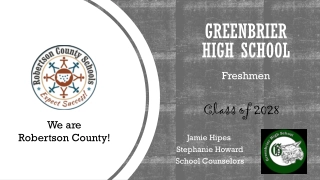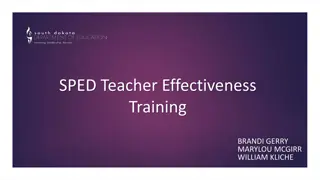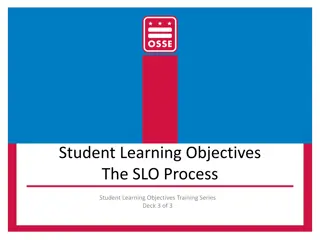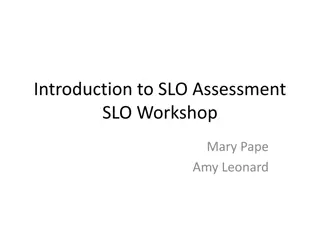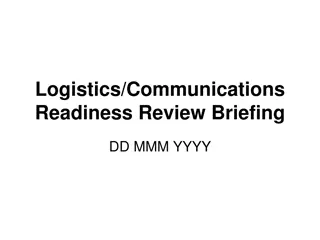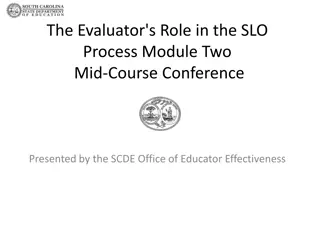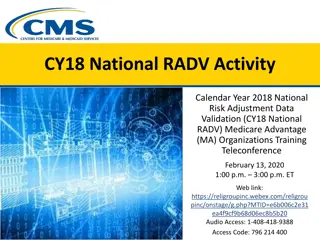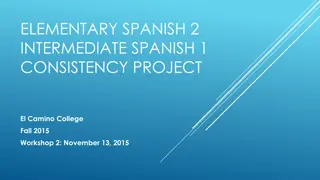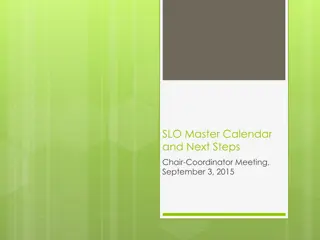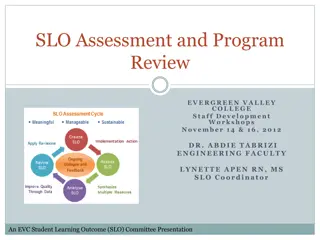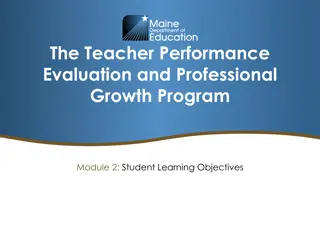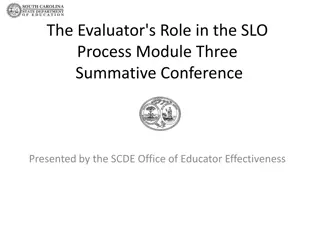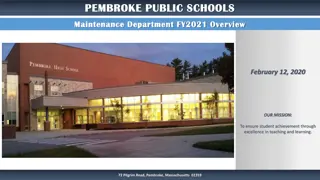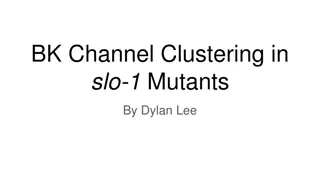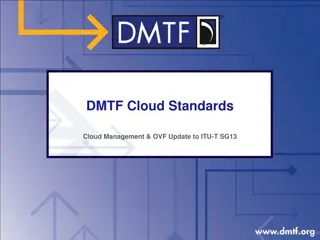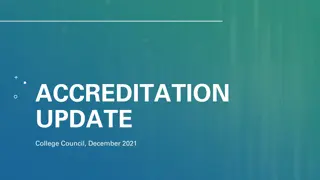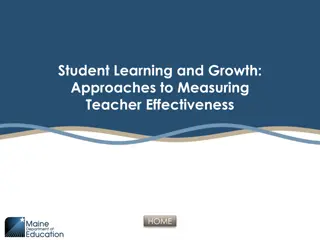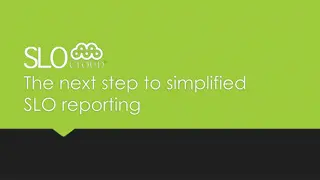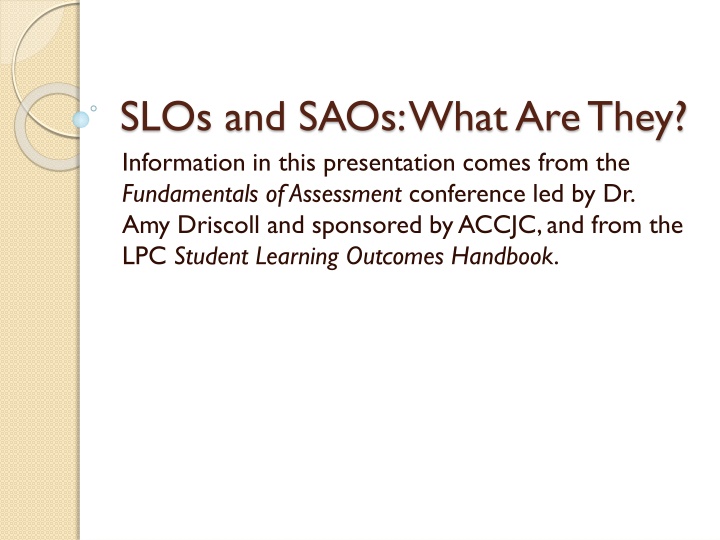
Understanding Student Learning Outcomes (SLOs) and Student Area Outcomes (SAOs)
Explore the concept of Student Learning Outcomes (SLOs) and Student Area Outcomes (SAOs) in educational settings, including their definitions, importance, and examples. Learn how SLOs and SAOs measure specific observable results of learning experiences, aiding in student assessment and program improvement.
Download Presentation

Please find below an Image/Link to download the presentation.
The content on the website is provided AS IS for your information and personal use only. It may not be sold, licensed, or shared on other websites without obtaining consent from the author. If you encounter any issues during the download, it is possible that the publisher has removed the file from their server.
You are allowed to download the files provided on this website for personal or commercial use, subject to the condition that they are used lawfully. All files are the property of their respective owners.
The content on the website is provided AS IS for your information and personal use only. It may not be sold, licensed, or shared on other websites without obtaining consent from the author.
E N D
Presentation Transcript
SLOs and SAOs: What Are They? Information in this presentation comes from the Fundamentals of Assessment conference led by Dr. Amy Driscoll and sponsored by ACCJC, and from the LPC Student Learning Outcomes Handbook.
What is an SLO/SAO? According to the Academic Senate for California Community College s SLO Terminology Glossary, Student learning outcomes (SLOs) are the specific observable or measurable results that are expected subsequent to a learning experience. These outcomes may involve knowledge (cognitive), skills (behavioral), or attitudes (affective) that provide evidence that learning has occurred as a result of a specified course, program activity, or process. An SLO refers to an overarching outcome for a course, program, degree or certificate, or student services area (such as the library). SLOs describe a student s ability to synthesize many discreet skills using higher level thinking skills and to produce something that asks them to apply what they ve learned. SLOs usually encompass a gathering together of smaller discrete objectives through analysis, evaluation and synthesis into more sophisticated skills and abilities.
Most courses have two to six SLOs Student service areas should have at least one SAO (Student Area Outcome).
What is an objective? According to the same glossary, objectives are small steps that lead toward a goal, for instance the discrete course content that faculty cover within a discipline. Objectives are usually more numerous and create a framework for the overarching student learning outcomes which address synthesizing, evaluating and analyzing many of the objectives.
Most courses have several measurable objectives
An example CSLO for English 4: Upon completion of English 4, students will be able to identify and evaluate implied arguments in college-level literary texts. Some measurable objectives that lead to the CSLO: Identify unstated premises and hidden assumptions which arise from the social, historical, moral, cultural, psychological, or aesthetic perspectives and contexts. Explain, analyze, and apply a literary argument and related critical evaluation using logical patterns of reasoning, such as induction and deduction. Identify logical and literary fallacies in fiction Distinguish between fact, inference, and judgment, recognizing that many reasonable inferences can be derived from the same facts
A easier way to think about outcomes An outcome clarifies what students come out of the course, program, institution, or service with. Students are often able to produce or do something as a result. What do you want students to be able to do when they leave the course or student service? How will they apply what they ve learned?
Bigger picture: How SLOs and SAOs fit in the assessment cycle Develop or modify SLOs [or SAOs] Develop, modify, or review a curriculum, course, program, or service Design and measure student learning as a result of the curriculum, course, or program [or service]. Determine refinements based on outcomes data Collect, discuss, and analyze data. Source: ASCCC SLO Terminology Glossary
An example Full-time and part-time faculty agree to assess following PSYC 1 SLO: Demonstrate fundamental knowledge and comprehension of the major concepts, theoretical perspectives, historical trends, and empirical findings in psychology. Next semester, faculty have a one-hour department meeting to discuss assessment results. Many faculty find that students are struggling to understand the section on the brain. The faculty collaborate to create a new unit on the brain. Individual faculty select what type of assessment will best capture the SLO (comprehensive final exam or smaller unit quizzes). By the end of the semester the assessment data are entered into eLumen.
Sources of outcomes Institutional mission and values National and international priorities Disciplinary associations Bloom s Taxonomy Faculty interest, commitments, and expertise Employer feedback Alumni feedback Student feedback Accreditation requirements
Learning outcomes are not... Descriptions of learning activities Descriptions of curriculum content Descriptions of a course or program Descriptions of the learning environment
The SLO Committee recommends... SLOs broad in scope, focusing on areas of knowledge, skills, or attitudes that are central to the course or program SLOs be measurable and use verbs from Bloom s Taxonomy that show higher level thinking (examples on next slide) 2-6 SLOs per course or program
High level Low level
Examining SLOs and SAOs Are the verbs specific, observable, measurable, open to description and common understandings? Does the outcome describe one outcome rather than several at a time? Is it clear? Will students understand it? Does it allow for a diverse array of methods of assessment?* (American Association for Higher Education s 9 Principles of Good Practice for Assessing Student Learning) *exceptions may apply
An example of how ISLOs, PSLOs, and CSLOs might be linked. ISLO: Students access, evaluate, and use information from technology sources. PSLO: Students access, evaluate, and use culinary information from technology sources. CSLO: Students access culinary information from multiple technology sources. CSLO: Students evaluate culinary information from multiple technology sources. CSLO: Students use culinary information from multiple technology sources.
Outcome or not? Students analyze situations to solve management problems Students practice writing to convince a future employer Students apply organizational skills to management situations
Outcome or not? Students analyze situations to solve management problems Students practice writing to convince a future employer Students apply organizational skills to management situations
Outcome or not? Students learn about the history of technology Students appreciate the role of technology in economics Students describe ethical considerations for technology Students practice using technology to solve problems
Outcome or not? Students learn about the history of technology Students appreciate the role of technology in economics (yes, though debatable) Students describe ethical considerations for technology Students practice using technology to solve problems
Outcome or not? Students work on writing skills for improvement Students experience different purposes of writing Students write compelling communication for varied purposes Students compare their early writing with later writing
Outcome or not? Students work on writing skills for improvement Students experience different purposes of writing Students write compelling communication for varied purposes Students compare their early writing with later writing
Outcome or not? Students identify and analyze community issues Students serve in community agencies to become aware of community needs Students reflect on community experiences to determine insights for citizenship Students describe self as citizen and evaluate readiness for role
Outcome or not? Students identify and analyze community issues Students serve in community agencies to become aware of community needs Students reflect on community experiences to determine insights for citizenship Students describe self as citizen and evaluate readiness for role
Outcome or not? Students describe steps of problem solving Students practice solving problems to have greater skill and understanding Students solve problems with consideration of multiple perspectives
Outcome or not? Students describe steps of problem solving Students practice solving problems to have greater skill and understanding Students solve problems with consideration of multiple perspectives
Whats my role? Become familiar with the course SLOs for the courses you teach, or the SAOs for your student service. Be sure you re assessing how your students are meeting those outcomes at least once during the semester. Depending on your discipline s SLO process, or your service s SAO process, enter data and reflections in eLumen for all or some of those assessments (often at the end of the semester).
Whats my role? Participate in discipline, division, and institutional discussions about student learning (including SLO/SAO results) Our current recommendation is disciplines discuss a course or SLO at least every three years, and as a part of this discussion, analyze the data that has been entered in eLumen since the course or SLO was last discussed.
Whats my role? In your discipline or student service, encourage ongoing review and development of the SLOs/SAOs themselves Does a new SLO/SAO need to be added to the course or service? (e.g., Isn t it important for a student taking any section of this course to be able to do X upon completion of the course?) Does a current SLO or SAO need revised? Are there any current SLOs or SAOs that aren t really outcomes?

![❤[READ]❤ Deep Space Craft: An Overview of Interplanetary Flight (Springer Praxis](/thumb/21511/read-deep-space-craft-an-overview-of-interplanetary-flight-springer-praxis.jpg)

